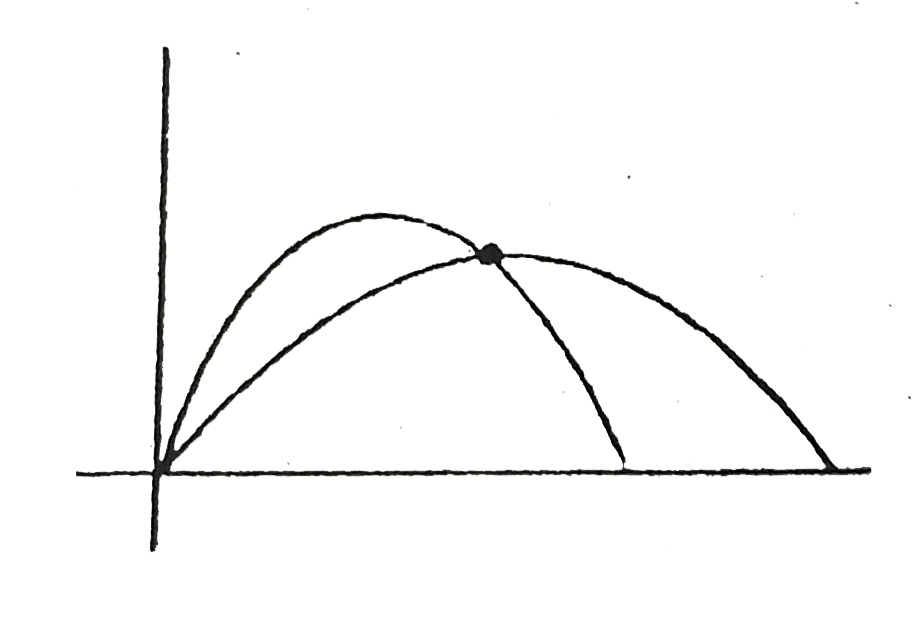STATEMENT 1 : Two stones are projected with different velocities from ground from same point and at same instant of time. Then these stones cannot collide in mid air. (Neglect air friction) STATEMENT 2 : If relative acceleration of two particles initially at same position is always zero, then the distance between the particle either remains constant or increases continuously wiht time.
Statement-1 is True, Statement-2 is True, Statement-2 is a correct explanation for Statement-1.
Statement-1 is True, Statement-2 is True, Statement-2 is NOT a correct explanation for Statement-1.
Statement-1 is True, Statement-2 is False.
Statement-1 is False, Statement-2 is True.
The correct Answer is:A
Topper's Solved these Questions
- KINEMATICSBOOK - MOTIONCHAPTER - KINEMATICSEXERCISE - EXERCISE 2 OBJECTIVE PROBLEMS
75 Videos
- KINEMATICSBOOK - MOTIONCHAPTER - KINEMATICSEXERCISE - EXERCISE 2 OBJECTIVE PROBLEMS (Level-2)
26 Videos
- KINEMATICSBOOK - MOTIONCHAPTER - KINEMATICSEXERCISE - EXERCISE 4 PREVIOUS YEAR (LEVEL 2)
6 Videos
- HYDROSTATIC, FLUID MECHANICS & VISCOSITYBOOK - MOTIONCHAPTER - HYDROSTATIC, FLUID MECHANICS & VISCOSITYEXERCISE - EXERCISE -3 (SECTION-B) PREVIOUS YEAR PROBLEM
7 Videos
- KINETIC THEORY OF GASES BOOK - MOTIONCHAPTER - KINETIC THEORY OF GASES EXERCISE - EXERCISE-3 SECTION-B
16 Videos
Similar Questions
Assertion:- Two stones are simultaneously projected from level ground from same point with same speeds but different angles with horizontal Both stones move in same vertical plane. Then the two stones may collide in mid air.
Reason:- For two stones projected simultaneously from same point with same speed at different angles with horizontal, their trajectories must intersect at some point except projection point.
View SolutionSTATEMENT - 1 : A particle is thrown by a man from ground. Minimum speed of the particle in the subsequent motion may not be zero. (Air resistance is neglected).
and
STATEMENT - 2 : Acceleration of the particle is never zero during the motion of the particle
View Solution
Knowledge Check
Two particles are projected simultaneously from the top of the towers as shown. Find the distance between the towers if they collide in mid air during their flight.
 A15mB20mC15√3mD5√3m
A15mB20mC15√3mD5√3mTwo particles start moving from the same point along the same straight line. The first moves with constant velocity v and the second with constant acceleration a. During the time that elapses before the sound catches the first, the greatest distance between the particle is.
Av2aBv22aC2v2aDv24aAssertion:- Two stones are simultaneously projected from level ground from same point with same speeds but different angles with horizontal Both stones move in same vertical plane. Then the two stones may collide in mid air.
Reason:- For two stones projected simultaneously from same point with same speed at different angles with horizontal, their trajectories must intersect at some point except projection point.AIf both Assertion & Reason are True & the Reason is a correct explanation of the Assertion.BIf both Assertion & Reason are True but Reason is not a correct explanation of the Assertion.CIf Assertion is True but the Reason is False.DIf both Assertion & Reason are False.
Two particles start moving from the same point along the same straight line. The first moves with constant velocity v and the second with constant acceleration a. During the time that elapses before the sound catches the first, the greatest distance between the particle is.
View SolutionStatement-1: Two stones were projected simultaneously from same point with same speed at different angles from horizontal as shown. They may collide at the point of intersection of their paths.

Statement-2: For two particles to collide they must be at the same point in space simultaneously.
View SolutionSTATEMENT - 1 : A particle is thrown by a man from ground. Minimum speed of the particle in the subsequent motion may not be zero. (Air resistance is neglected).
and
STATEMENT - 2 : Acceleration of the particle is never zero during the motion of the particle
View SolutionA ball projected from ground vertically upward is at same height at time t1andt2. The speed of projection of ball is [Neglect the effect of air resistance ]
View SolutionStatement-1: During flight under action of gravity, the change in velocity of a projectile in same time interval is same. (Neglect air friction) Statement-2: Neglecting air friction, the acceleration of projectile is constant during flight.
View Solution
